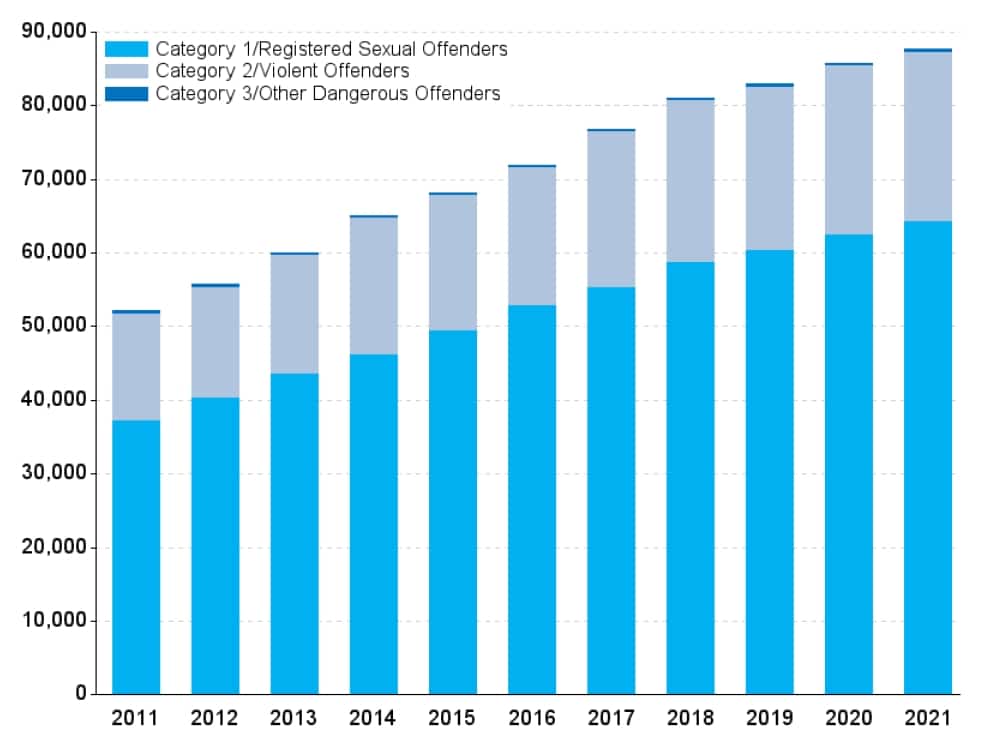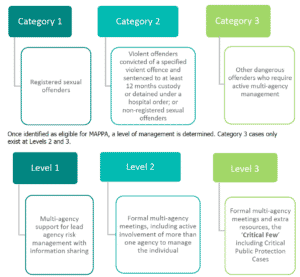MAPPA population has grown 70% in a decade
There has been a lot of concern recently about the government’s multi-billion investment in prison building with projections of 20,000 more people in prison in five years’ time. But one criminal justice population which has been growing even faster, rarely gets a mention. On 31 March this year there were 87,657 people under MAPPA supervision, almost 10,000 (9,659) more than the prison population. This figure represents a 2% increase on last year and a staggering 70% rise over the last decade.
What are MAPPA?
Multi-Agency Public Protection Arrangements (MAPPA) are a set of statutory arrangements to assess and manage the risk posed by certain sexual and violent offenders. MAPPA bring together the Police, Probation and Prison Services to form the MAPPA Responsible Authority for each MAPPA Area.
Some other agencies are under a duty to co-operate with the Responsible Authority. These include Children’s Services and Adult Social Care, Health Trusts and Authorities, Youth Offending Teams, Home Office Immigration Enforcement, local housing authorities and certain registered social landlords, the Department of Work and Pensions and electronic monitoring providers.
The period an offender remains under MAPPA varies significantly. Some will be MAPPA offenders for life and some for less than 6 months. The period will be dependent upon the offence committed and the sentence imposed.
There are 3 broad categories of offenders under MAPPA:
- Category 1 – Offenders subject to notification requirements. These are offenders who have been convicted of a specified sexual offence and who are therefore required to notify the Police of their name, address and other personal details.
- Category 2 – Violent offenders. These are offenders who have been convicted of a specified violent offence and sentenced to imprisonment/detention for at least 12 months or detained under a hospital order. This category also includes a small number of sexual offenders who do not qualify for the notification requirements that apply to Category 1 offenders.
- Category 3 – Other Dangerous Offenders. These are offenders who do not qualify under Category 1 or 2 but have been assessed as currently posing a risk of serious harm. The link between the offence they have perpetrated and the risk that they pose means that they require active multi-agency management.
I’m covering MAPPA on the blog today because the MoJ & Office for National Statistics published the MAPPA annual report for 2020/21 last Thursday (28 October 2021).
Management levels
The overwhelming majority (currently 98% and at least 97% since 2014) of MAPPA offenders continue to be managed at Level 1. On 31 March 2021, 86,268 offenders were being managed at Level 1, 2% higher than in last year and 37% higher than in 2014. About 7 in 10 of those managed at Level 1 are Category 1 offenders, broadly consistent in the last decade. Category 3 offenders cannot be managed at Level 1 as they only qualify for MAPPA if they require multi-agency management to be overseen by a formal meeting at level 2 or 3.
The MAPPA population managed at level 2 has trended downward, although annual changes since 2015 have been smaller. The Level 2 population on 31 March 2021 was 1,233, an increase of 3% from last year but a decrease of 34% from 2014. The Level 2 population is made up of about equal proportions of Category 1 (37%) and Category 2 (36%) offenders. In the last three years the number of Category 1 offenders at Level 2 has continued to decrease while numbers in Category 2 and Category 3 have been relatively stable.
The Level 3 population (those people regarded as potentially the most dangerous) has fluctuated between 140 and 160 since 2014, and the latest figure of 156 is a decrease of 1% from last year. In contrast with other management levels, Level 3 has Category 2 (violent) offenders as the largest proportion (40%), followed by Category 3 offenders (35%) and Category 1 (25%).
Diversity
For the first time, the MoJ has published “experimental” data on the diversity of the MAPPA population managed at Level 2 and 3. Here are the main findings:
- 95% of offenders managed at MAPPA Level 2 or 3 are male.
- 6% of Level 2 and 3 offenders are Asian, 11% are black and 73% are white.
- 35% are 30 years of age or younger, 46% are 31-50 and 19% are over 50.
Serious Further Offences
SFO charges decreased by 13% to 168, and SFO convictions decreased by 42% to 85 in the latest period. The decrease in convictions is at least partly due to reduced court activity during the COVID-19 pandemic.
Licence recalls
Returns to custody following licence recall increased for offenders managed at Level 2 and Level 3 in the latest year, increasing by 9% to 785 people.
Revocation of lifetime notification requirements
Finally, we look at the number of sex offenders who no longer have to notify the policy when they move address. Individuals subject to indefinite notification will only become eligible to seek a review once they have been subject to the indefinite notification requirements for a period of at least 15 years for adults and 8 years for juveniles. Between April 2020 and March 2021, 402 Category 1 Offenders had their lifetime notification requirements revoked on application, compared to 411 in 2019/20.






